2019 Year in Review - NREL's Top 20 Stories
Researchers at the National Renewable Energy Laboratory (NREL) achieved many goals across the spectrum of energy efficiency and renewable energy technologies in 2019, and the news coming from the laboratory shows it. Below are some highlights from the past year—click on each headline to read more.
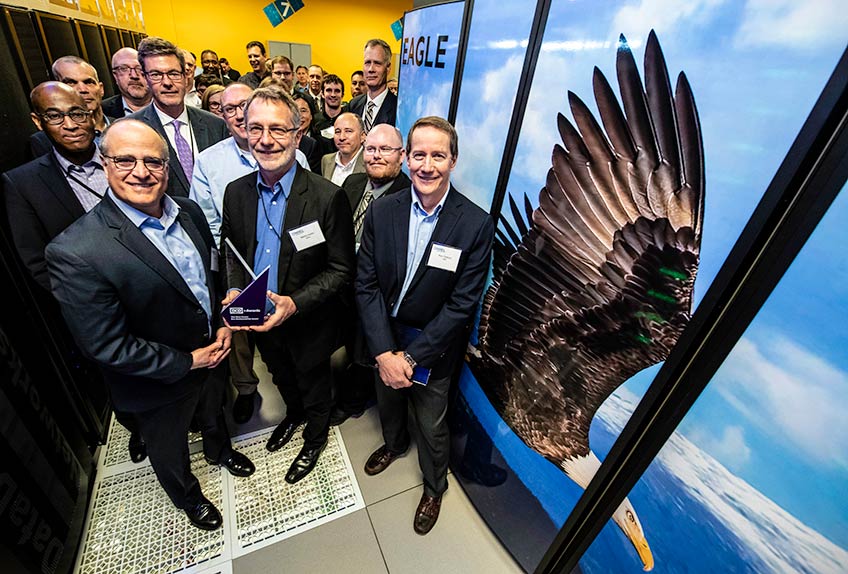
January 8
NREL already had the world's largest supercomputer dedicated to energy efficiency
and renewable energy, Peregrine—but with its replacement system, Eagle, the laboratory's
computing capability has more than tripled. Now in production use, the ultra-efficient Eagle high-performance computer will power scientific insights to accelerate our energy system transformation. With
a peak performance of 8.0 petaflops, meaning it can carry out 8 million-billion calculations
per second, Eagle also features a warm-water liquid-cooled design that was originally
developed for Peregrine.
2. Five NREL Scientists Recognized as Highly Cited Researchers
January 9
NREL researchers Matthew Beard, Keith Emery, Giles Eperon, Joseph Luther, and Arthur
Nozik were named among the most internationally influential scientists according to
the 2018 list of Highly Cited Researchers. The achievement means their published work
was among the top 1% of most-cited papers in their respective scientific fields. The
list, published by Clarivate Analytics, highlights more than 6,000 researchers around
the globe across 21 different disciplines. The NREL researchers work in various fields
including engineering, chemistry, and physics. For the first three, this accomplishment
is a career first; for the other two, it's a repeat performance.
3. NREL Pioneers Cleaner Route to Upcycle Plastics into Superior Products
February 27
By chemically combining reclaimed polyethylene terephthalate (PET) plastic, in the
form of single-use beverage bottles, with bio-based compounds, NREL researchers produced
higher-value fiber-reinforced plastics (FRPs) that can be used in products from snowboards
to vehicle parts to wind turbines. Not only are the resulting composites worth more
than double the original PET, the FRPs exhibit twice the strength and improved adhesion
to fiberglass when compared with the standard petroleum-derived FRP.
4. NREL's Economic Impact Tops $1 Billion
March 13
A study released in 2019 found that, in fiscal year 2017, NREL's economic impact amounted
to more than $1.1 billion nationwide. NREL continually seeks to expand its impact
by working with academia, as well as the public and private sectors. In FY 2017, NREL
had 739 active partnership agreements with 513 partners. During the same fiscal year,
NREL signed $80 million in new partnership agreements.
5. Beneath Solar Panels, the Seeds of Opportunity Sprout
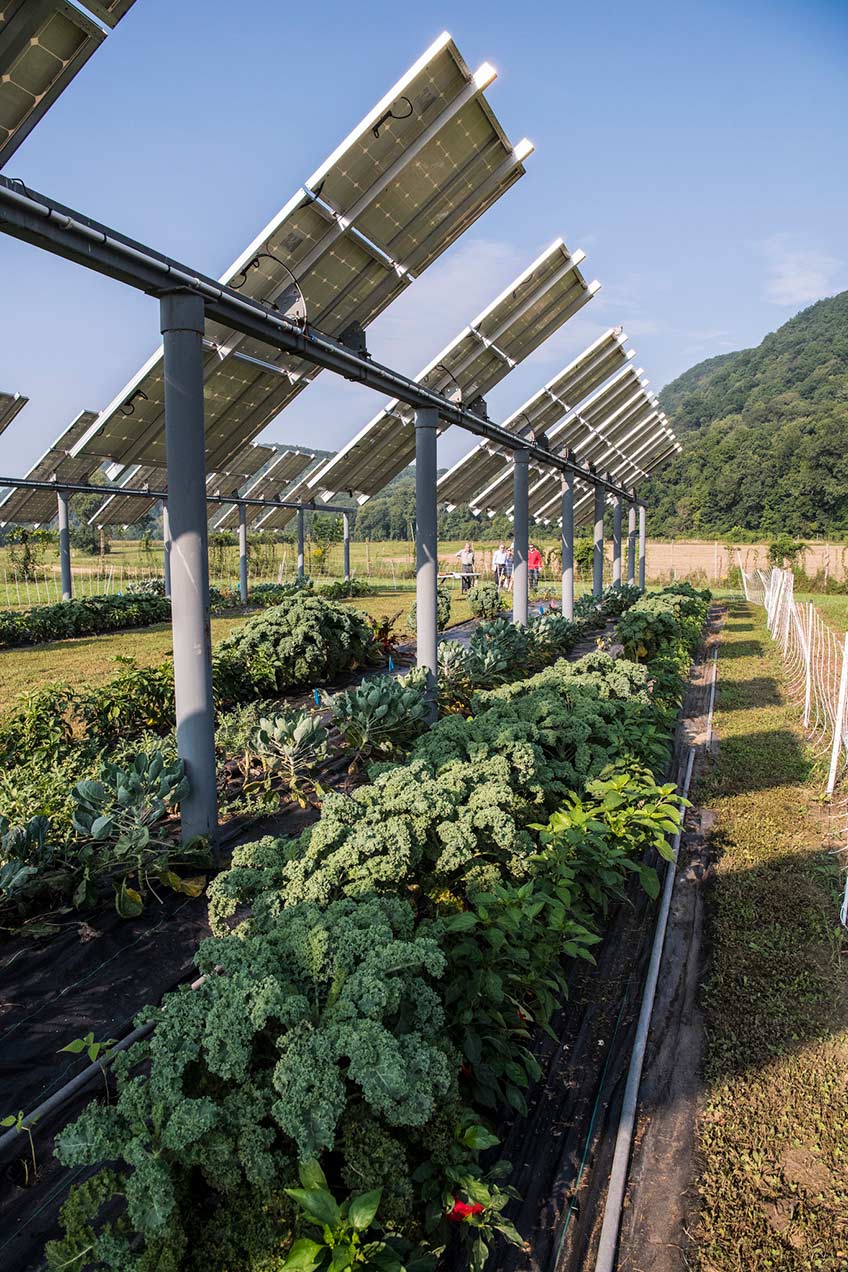
April 2
By 2030, utility-scale solar installations could cover almost 2 million acres of land
in the United States. Traditional solar development would monopolize this land for
just one use: energy production. Low-impact solar development, on the other hand,
might also improve soil health, retain water, nurture native species, produce food,
and provide even lower-cost energy to local communities. The Innovative Site Preparation
and Impact Reductions on the Environment (InSPIRE) project brings together researchers
to better understand the benefits of—and barriers to—low-impact solar development.
6. New NREL and Georgia Tech Collaborative Appointment Program Launched
April 16
NREL and the Georgia Institute of Technology announced a new joint appointment program
as part of an effort to enhance research collaboration between the laboratory and
universities. The agreement establishes an official avenue for the exchange of Georgia
Tech faculty and NREL employees across both institutions. The formal collaboration
will initially focus on the fundamental research and development of advanced wide
bandgap technologies used in electrical power transfer applications—such as vehicle
drive systems, building technologies, and solar inverters.
7. ExxonMobil Partnership Will Support National Lab Research for Future Energy Solutions at Scale
May 8
A new $100 million agreement between ExxonMobil, NREL, and other U.S. Department of
Energy (DOE) national laboratories will accelerate development of transformative advanced
energy technologies with a focus on reducing emissions. The Texas oil and gas giant,
which reported $21 billion in earnings during 2018, will fund the new partnership
over 10 years. The commitment from ExxonMobil stands out as the largest single external
investment in research at NREL in the laboratory's history.
8. Could Batteries Provide Peaking Capacity on the Grid? With Declining Cost Projections, NREL Analysts See Potential
July 10
Battery energy storage costs have changed rapidly over the past decade. What might
this mean for future utility-scale battery deployment? New NREL analyses suggest some
possibilities: as costs are projected to fall for battery storage over the next few
decades, the technology's cost competitiveness increases for a variety of applications—one
being providing peaking capacity. In a recent report, NREL researchers document cost and performance projections for utility-scale lithium-ion
battery systems, with a focus on four-hour-duration batteries.
9. White House Honors Two NREL Researchers with Early Career Awards
July 16
Mike Wagner and Timothy J. Silverman became the first researchers at NREL to ever
receive the Presidential Early Career Award for Scientists and Engineers (PECASE).
The PECASE is awarded annually and is the highest honor bestowed by the United States
government to “outstanding scientists and engineers who are beginning their independent
research careers and who show exceptional promise for leadership in science and technology,”
according to the White House announcement.
10. Three NREL Scientists Receive Prestigious DOE Early Career Research Funding
August 1
The DOE Office of Science selected three researchers from NREL to receive significant
funding as part of its Early Career Research Program. The three NREL researchers—Davinia
Salvachúa Rodriguez, Cara Lubner, and Andriy Zakutayev—are among 70 other researchers
from institutions across the country named who will each receive $2.5 million over
the next five years to further their respective research efforts. Read more about
what each is working on in the stories below:
- The Role Fungi Will Play in NREL's Biomass Research
- Atomic-Level Look at Energy Already Solved One Mystery
- Funding Provides Boost to Investigation of Nitrides
11. From the Bottom Up: Designing a Decentralized Power System
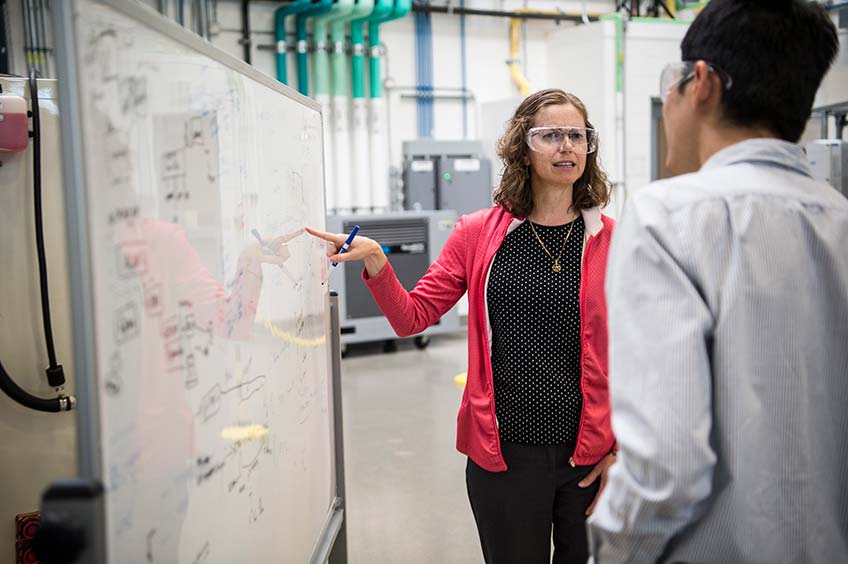
A far-reaching vision for the future of the electric grid is emerging at NREL. In the past few years, this vision has grown from a theory on whiteboards to real-power experiments on lab hardware. It's called "Autonomous Energy Grids" (AEG), an effort to ensure the grid of the future can manage a growing base of intelligent energy devices, variable renewable energy, and advanced controls. The AEG effort envisions a self-driving power system—a very "aware" network of technologies and distributed controls that work together to efficiently match bi-directional energy supply to energy demand. This is a hard pivot from today's system, in which centralized control is used to manage one-way electricity flows to consumers along power lines that spoke out from central generators.
12. Exploring Tomorrow's Energy Solutions, Together
August 22
NREL's 2019 Partner Forum brought together energy industry leaders across multiple
sectors to discuss today's energy challenges and explore tomorrow's potential solutions.
While their backgrounds were diverse, the entities represented at the third annual
forum had one thing in common: They all face very real energy-related challenges in
the years and decades ahead—challenges greater than any one company or organization
can solve alone. The goal is to inform future laboratory research and cultivate the
partnerships that will develop and commercialize new technologies to advance the U.S.
energy market.
13. NREL Marks Partner Forum with Dedication of Bioreactor
August 22
Installed outside NREL's Energy Systems Integration Facility, a new hydrogen-to-methane bioreactor is the first of its kind in the United States.
It uses a selectively evolved microorganism that feeds on renewable hydrogen produced
at NREL and a diet of carbon dioxide to produce pipeline-quality methane. The microorganism,
known as Methanothermobacter thermautotrophicus, is a thermophile, meaning it thrives in hot environments. The temperature inside
the bioreactor is about 150°F.
14. NREL Appoints Three Scientists as Senior Research Fellows
September 4
A trio of scientists at NREL—Matthew Beard, Bryan Pivovar, and Paul Veers—are being
elevated to senior research fellows, chosen for their significant contributions to
NREL and the larger scientific community. Along with other current research fellows, these individuals will advise NREL executive management on the strategic direction
of science and technology research and ensure NREL's work continues to meet the highest
standards for quality and objectivity. In addition, the Materials Research Society
(MRS) named Peter Green a fellow. Green, the deputy laboratory director for Science
and Technology and the chief research officer for NREL, becomes only the third person
from the laboratory to be named an MRS fellow.
15. Automated Electric Shuttle Makes its Debut on NREL Campus
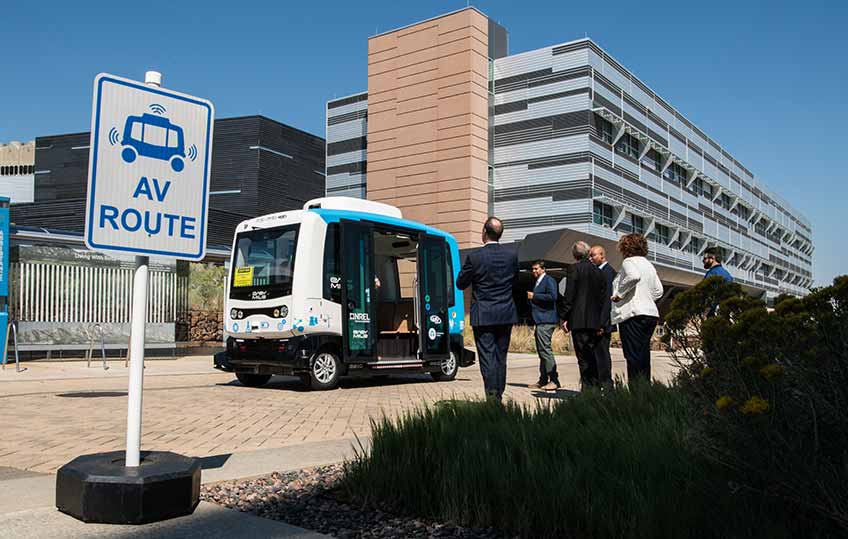
NREL's intelligent campus ventures accelerated this year with the introduction of an automated electric vehicle in its employee shuttle fleet. Designed to cover short distances along pre-programmed routes, the fully electric EasyMile EZ10 shuttle transports staff and visitors around NREL's South Table Mountain campus. The shuttle can carry up to 12 passengers and is equipped with a full range of sensors and an intelligent vehicle system to detect obstacles and avoid collisions. Real-time data processing allows the driverless vehicle system to decide how to behave as it progresses safely along the road.
16. NREL Joins Forces with Other National Labs on $100M Clean Water Hub
September 23
The DOE has selected a research consortium founded by a quartet of national labs—including
NREL—for a five-year, $100-million Energy-Water Desalination Hub to address water
security issues in the United States. Called the National Alliance for Water Innovation
(NAWI), its mission is to focus on early-stage research and development for energy-efficient,
cost-competitive desalination technologies, as well as ways for treating nontraditional
water sources for multiple end uses. NAWI's vision for creating a stable and resilient
water supply for agriculture, industry, and communities involves a circular water
economy, where water is treated to fit-for-purpose standards and reused locally, rather
than transporting freshwater long distances.
17. National GEM Consortium Honors NREL Director Keller
October 2
The National Graduate Education for Minority Students (GEM) Consortium honored NREL
Director Martin Keller with its Corporate Leadership Award. Founded in 1976, the National
GEM Consortium has a mission to increase the participation of underrepresented groups
at the master's and doctoral levels in science, technology, engineering, and math
(STEM). Since that time, GEM has awarded more than 4,000 African Americans, American
Indians, and Hispanic Americans with fellowships, including an expanding number at NREL.
18. A New Way to Measure Mobility Potential of Cities
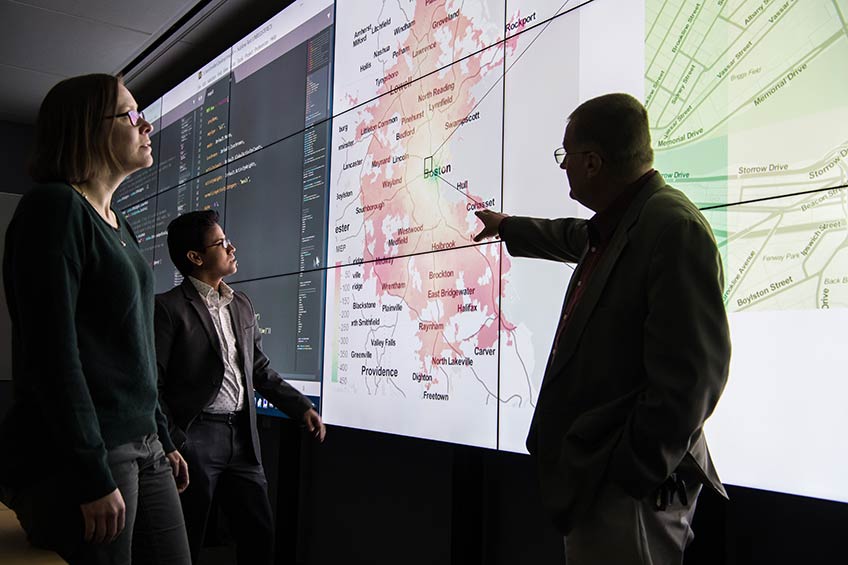
Many people looking for a new house have considered metrics like “walk score” or “transit score,” and even “bike score.” But what most don't know is that these metrics, while useful, aren't designed to capture the whole story of an area's transportation options. The Mobility Energy Productivity (MEP) metric comprehensively quantifies the efficiency of transportation systems while taking time, affordability, and energy use into consideration. The MEP metric measures the existing and potential impact of all mobility options in a given area. And it does so in a way that assesses both existing and future mobility options.
19. R&D 100 Awards Honor Two NREL Innovations
October 29
Given annually, the R&D 100 Awards honor the 100 most innovative technologies of the
past year and were chosen by an independent panel of judges. NREL technologies won
in these categories:
- IT/Electrical, for PRECISE, a tool that allows utilities to identify optimal inverter modes and settings. PRECISE, which stands for PREconfiguring and Controlling Inverter SEt-points, maximizes the cost-effective use of installed solar systems.
- Software Services, for ResStock, a building analysis tool that allows states, municipalities, utilities, and manufacturers to identify which home improvements save the most energy and money.
20. NREL and HPE Team Up to Apply AI for Efficient Data Center Operations
November 18
Artificial intelligence (AI) is the latest buzzword in energy innovation—and when
it comes to operating energy-intensive data centers, AI could be the key to improved
efficiency. That's why NREL has partnered with Hewlett Packard Enterprise on a new
research effort that will evaluate how applying AI in NREL's High-Performance Computing (HPC) Data Center could improve operations. By learning historical trends and training models to operate
on real-time data collected from the systems and facilities, AI and machine learning
approaches could improve HPC data center operational efficiency as supercomputers
approach exascale capability.
The above stories are just a snapshot of all the amazing research taking place each day at NREL. Visit our News and Feature Stories webpage to discover more ways that NREL is pursuing science, development, commercialization, and deployment of renewable energy and energy efficiency technologies.
Thank you to everyone who helped make 2019 a successful year in renewable energy research! Here's to continuing to transform energy in 2020 and beyond.
Last Updated May 28, 2025
